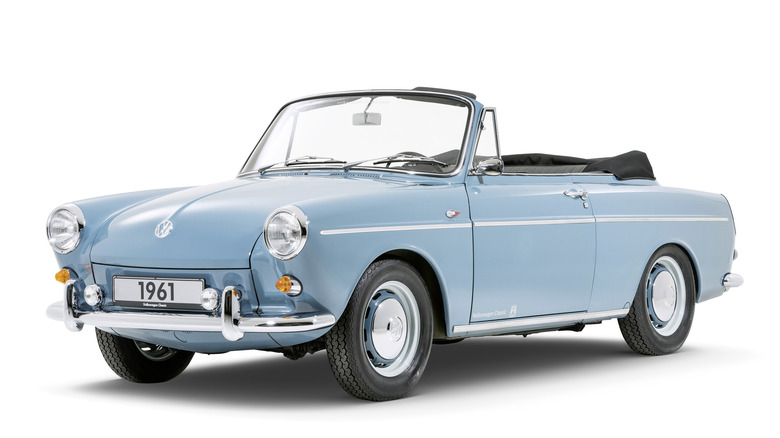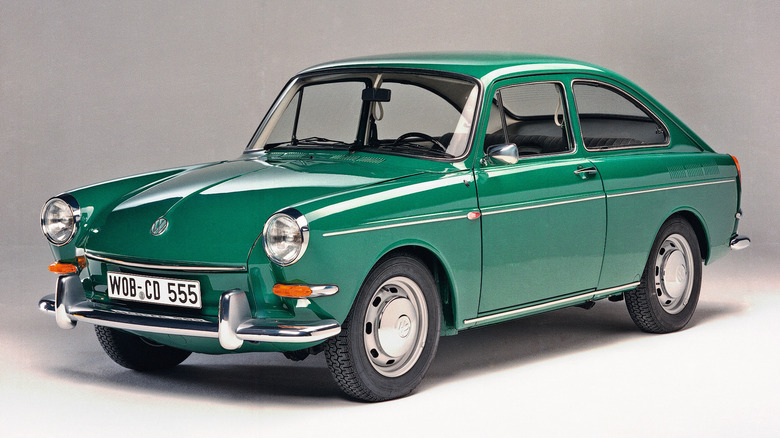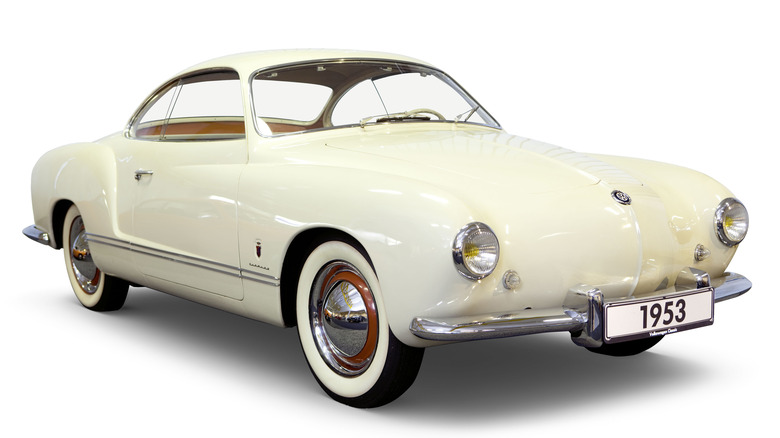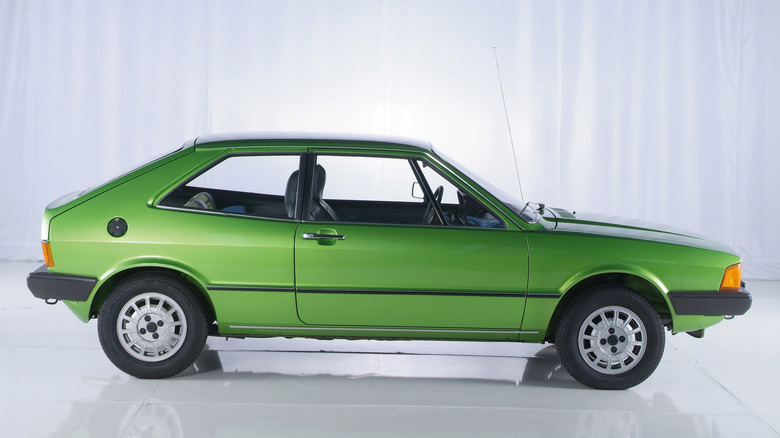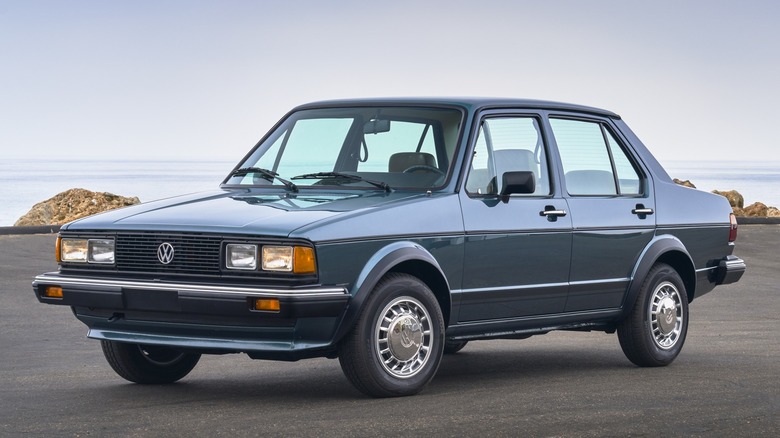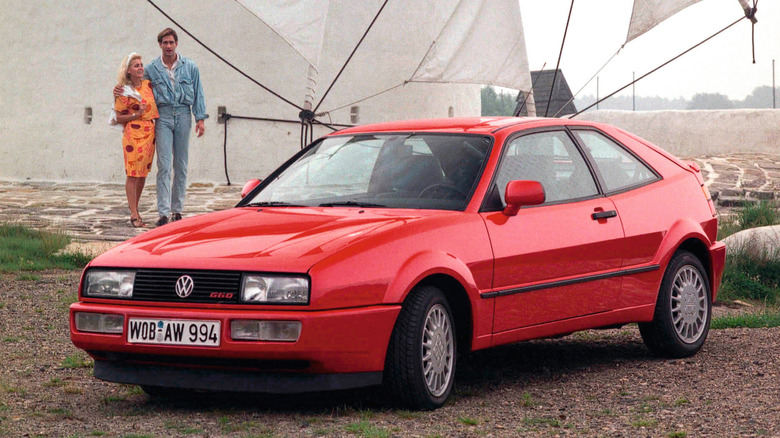5 Classic Volkswagen Models That Will Look Great In Any Garage
Volkswagen has made a wide variety of visually attractive vehicles throughout its 90-year history. From its Beetle-based rear-drive, air-cooled era to its front-drive, water-cooled cars that began in the 1970s, there are numerous VWs that will look great in any garage. The focus here is on the "look great" part, so let's focus on the more appealing Volkswagen vehicles from the company's back catalog.
To establish my credibility, let me share the range of my VW ownership and driving experiences with you. I have owned a 1971 Karmann Ghia, a 1974 Dasher, and a 1981 Mk1 Scirocco (for 34 years). My family members have owned a 1963 Beetle, two 1980 Jettas, 1977 and 1978 Rabbits, a 1979 Rabbit Diesel, a 1981 Jetta Diesel, 1990 and 2001 Passats, a 1991 Cabrio, and a 1999 Beetle. My brother-in-law is also a hardcore enthusiast who worked for Volkswagen (and Saab) as a West Coast District Sales Manager during the late 1970s and early-to-mid 1980s. Through his experiences, I came to understand the highs and lows of the automotive import sales game, including the European marques' limited understanding of how the American market worked and what the customers here really wanted. He was also able to borrow some very cool VWs on the weekends!
I experienced the transition from air-cooled to water-cooled powertrains, the pleasures of driving these well-engineered cars, and the challenges of maintaining them as they age. But that's another topic for another article — it's time to select what I believe are the five classic Volkswagen models that will look great in any garage.
1961-73 Volkswagen Type 3 Fastback
Our first entry is the VW Type 3 Fastback. It was joined in VW showrooms by a wagon-roofline version, the Squareback (the notchback model was never shipped to the U.S.). The Type 3 Fastback is the choice here, due to its sporty sloping roofline. The lead image, a Type 3 convertible, is a prototype made by Karmann that, unfortunately, was never cleared for production. Too bad.
Volkswagen had a problem in its home market — Germans were tired of "The People's Car" and desired something more upscale. This led VW to design the Type 3, which looked like a new model but could be assembled alongside the Beetle in VW's original Wolfsburg plant. Meanwhile, in the U.S., we couldn't get enough Beetles, so there was no need to ship us any additional VW models immediately. Once VW's new Emden plant came on line, there was production capacity available, so VW started sending Fastbacks and Squarebacks to America for the 1966 model year.
While the Type 3 was a Beetle at heart, it did have some notable advances. Front disc brakes were included, as was Bosch fuel injection on the 1600cc air-cooled engine starting in 1968. A three-speed automatic transmission was an option. There were two trunks, front and rear.
The Volkswagen Type 3 Fastback may not have been appreciated for its appearance back in the day. But as VW's first attempt at contemporary styling on an upscale mass-market vehicle, the Fastback retains its own enduring Germanic sense of style.
1956-74 Volkswagen Karmann Ghia
The beautiful Volkswagen Karmann Ghia (KG) actually began as a Chrysler concept car. Chrysler had a contract with coachbuilding firm Ghia to produce several "image cars," some of which made it to production. One that did not was acquired from Ghia by Karmann, who was already making the Beetle convertible for VW. The Ghia design was adapted to use a Beetle floorpan, and the Karmann Ghia was born as a prototype in 1953 (our KG photo is that prototype).
The Karmann Ghia Coupe went into production in Europe in 1955 with very few changes. It arrived in the U.S. in 1956, and it was followed by a convertible (specifically designed for our market) in 1958. The KG had a 19-year production run (18 for the convertible) in visually unchanged form, which is proof that its design aged very well. A total of 441,950 Karmann Ghias (362,624 coupes and 79,326 convertibles) were produced in Germany during this period, of which enough have survived to support a flourishing online auction market with plenty of KG enthusiast support. The successful Volkswagen Karmann Ghia has become an affordable classic.
While the example I owned was well-used before I acquired it, it retained all of that great VW air-cooled reliability, along with a complete lack of heating and defrosting during the cold Pennsylvania winters. It was a classic in every possible way, both good and bad.
1974-81 Volkswagen Scirocco
The Mk1 Volkswagen Scirocco (known internally as Type 53) was technically the successor to the Karmann Ghia when it first appeared in 1974, arriving in the U.S. in 1975. But the new VW sports coupe was nothing like the KG that it replaced. A fresh, modern Giorgio Giugiaro design based on the upcoming Golf/Rabbit platform replaced the Karmann Ghia's Chrysler-inspired look of the 1950s. Replacing the KG's air-cooled, rear-engine, flat-four setup was the Scirocco's transversely placed inline-four driving the front wheels. While some European trim levels used two large rectangular headlights, all U.S. versions came with four round headlights.
The revolutionary Scirocco was the first Volkswagen that emphasized sporty performance, compared to all of the middle-of-the-road air-cooled VWs that had preceded it. The Scirocco was actually released several months before the Golf/Rabbit appeared in VW showrooms. The Scirocco, like the Golf, had a strut suspension in the front, with a twist-beam, coil-sprung, semi-independent setup in the rear. The VW Scirocco offered anywhere from 50 horsepower in the entry-level model up to 110 horsepower in the non-U.S. 1976 GTI model. This was in a car that weighed only 1,764 pounds (800 kilograms)!
Over 500,000 examples of the first-generation Scirocco were sold worldwide. Today's surviving examples are up to 50 years old and are very thin on the ground. Scirocco Mk1s can be occasionally found when they come up for sale on online auction sites, ranging in price from $3,000 to $40,000, depending on mileage and condition. I loved mine for 34 years of ownership, selling it before moving cross-country.
1980-84 Volkswagen Jetta
Americans like trunks on their cars much better than they like hatchbacks. This fact led Volkswagen to introduce the Giugiaro-styled Jetta for the 1980 model year. Starting out as simply "a Rabbit with a trunk," VW did its best to differentiate the Jetta from its Rabbit sibling. In addition to the 14.1 cu. ft. trunk grafted onto the rear, VW restyled the front end around a quartet of rectangular sealed-beam headlamps. Inside, the Jetta provided a more upscale ambience than the Rabbit could, with standard velour upholstery and wall-to-wall carpeting for its occupants. Power-assisted brakes and an AM/FM cassette stereo were also standard. Air conditioning, automatic transmission, and a sunroof were some of the few options. Soon after its introduction, the Jetta earned the status of the best-selling German vehicle in the U.S. Both 2-door and 4-door body styles were offered.
The U.S. Jetta may have only had an output of 76 horsepower from its 1.6-liter engine (the one-year-only 1984 GLI had 90 horses), but with its fuel-injected engine (which most competitors lacked), it avoided the carburetor-based, emissions-related stumbling that the majority of similar vehicles suffered from. Both of my family's 1980 VW Jettas had the combination of automatic transmission and air conditioning, and while they were not extremely fast, they ran smoothly and could keep ahead of traffic. I put many thousands of miles on these Jettas in the Appalachian foothills of Pennsylvania and came to appreciate their understated sense of style, their crisp handling, their front-drive traction, and their no-nonsense approach to everyday driving challenges.
1988-95 Volkswagen Corrado
The Volkswagen Corrado replaced the Mk2 Scirocco, but it arrived with a $17,900 price tag, much higher than the outgoing Scirocco. The Karmann-built Corrado debuted in the U.S. in 1990 with the infamous 158-horsepower 1.8-liter "G60" supercharged engine, which, according to unlucky owners, tended to "Grenade" itself at around 60,000 miles. Expensive preventative maintenance is required to prevent this from happening.
The Corrado received the narrow-angle 2.8-liter, 178-horsepower VR6 engine that replaced the problematic G60 during the 1992 model year. It was the first VW in the U.S. to have a six-cylinder engine. The reason that a six fits is that the vee-angle is only 15 degrees. An easy way to tell cars with the two engines apart is by the engine-type badging (G60 or VR6) on the grille and the red "SLC" badge on the rear of VR6 cars.
A former business partner of mine owned a 1990 Corrado G60, and I had some seat time in it. It was a worthy successor to my Mk1 Scirocco, with a more solid, planted feel and lots more power. Unfortunately, he lost control of it on an icy Interstate while passing a semi and totaled it, long before it could reach the 60,000-mile mark.
Corrado sales were disappointing, and the 1994 model was the last to be sold here. This rarity, along with the VR6's inherent goodness, has contributed to the underrated German car's increasing value in the auction market. A low-mileage VR6 in excellent condition recently sold online for $47,000.
